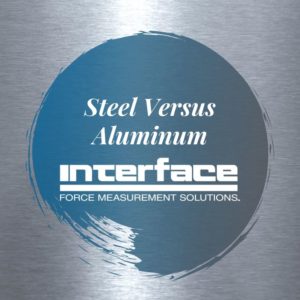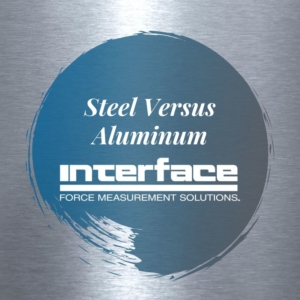Considerations for Steel, Stainless Steel and Aluminum Load Cells
 In the world of force measurement and load cells, one size certainly does not fit all. There are thousands of different options for size and force ranges, and our load cell configurations vary widely based on the requirements of your project. Whether you are designing and testing products for the medical industry, or measuring force deep within a mine shaft, users need to be aware of certain force product details to ensure their getting the right tools for the job.
In the world of force measurement and load cells, one size certainly does not fit all. There are thousands of different options for size and force ranges, and our load cell configurations vary widely based on the requirements of your project. Whether you are designing and testing products for the medical industry, or measuring force deep within a mine shaft, users need to be aware of certain force product details to ensure their getting the right tools for the job.
One of the critical considerations in the load cell selection process are the materials used in the construction of the load cell. If you did not already know, load cells can be made from several different metal materials. This list includes aluminum, steel, stainless steel, titanium, Inconel®, and even glass or carbon fiber.
Each material used depends on the end-use requirements and the need for strength, resistance, hysteresis, environmental concerns, output signal, size and weight, and budget.
For this post, the focus is on the three most used materials for load cells: aluminum, steel and stainless steel. Below is an outline comparing the different factors that make one material better than the others based on the testing requirements and use case.
Aluminum
Aluminum is a light and inexpensive metal, making it the most budget-friendly of the three. It is also the easiest to machine, as it does not require a heat treatment or secondary machining. Aluminum has a higher thermal conductivity, which can be a good or bad thing depending on your need. The hysteresis of aluminum load cells is also the lowest on this list. The most prominent benefit is that it can be used for constructing smaller load cells, so if size, weight, and total volume of the load cell is a key consideration for your project, aluminum would be the metal we’d recommend.
In adverse, when dealing with aluminum load cells it is important to understand that it is the softest material on this list, which means it is more susceptible to damage. This also means that it cannot handle as much stress, resulting in a lower output signal.
Steel
Steel is a stronger metal, so it is a bit more expensive than an aluminum load cell. It is still comparatively cost-effective. It also has the highest strength of the three materials outlined here. This means it is the least susceptible to damage and has the highest signal output. It also has higher environmental resistance than aluminum and less heat conductivity, which once again can be good or bad depending on the project.
The downsides to steel include the fact that it is more complicated to machine and requires a multi-step heat treatment operation. Compared to aluminum, the hysteresis is generally slightly higher for certain load cell designs. This can be remedied with additional engineering. It also does not provide the benefit of size, weight, and total volume flexibility that lighter aluminum provides.
In our opinion, steel provides the best value for a load cell in terms of money and performance, if size, weight and total volume is not an issue with your project or application.
Stainless Steel
 Stainless steel is a stronger material than aluminum; however, it is not as strong as steel. The output signal performance for stainless steel load cells is somewhere in the middle of steel and aluminum. The main benefit of stainless steel is that it is the best material to use in a corrosive environment because of the metal’s environmental resistance properties.
Stainless steel is a stronger material than aluminum; however, it is not as strong as steel. The output signal performance for stainless steel load cells is somewhere in the middle of steel and aluminum. The main benefit of stainless steel is that it is the best material to use in a corrosive environment because of the metal’s environmental resistance properties.
The downside to stainless steel is that it is a bit more difficult to machine but does only requires a simple heat treatment process. It is also the most expensive metal of the three and has the highest hysteresis. We would recommend stainless steel when the user needs to collect data in a hazardous environment. Read more here about our Ex Rated products.
Understanding the difference between these materials is critical to getting the most accurate data from your force tests based on the environment and the nature of the product or system you are testing.
If you’re unsure about the requirements your project demands, be sure to reach out to us at 480-948-5555, or visit our website to be connected with an application engineer. We can discuss your specific challenge and help you select the load cell with the right material for your needs.
Contributor Ken Vining, Chief Engineer at Interface









